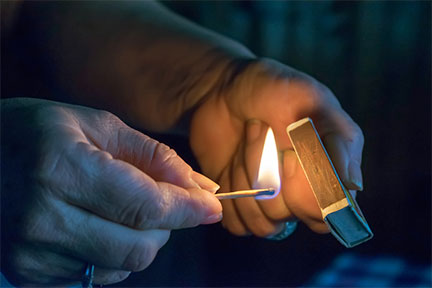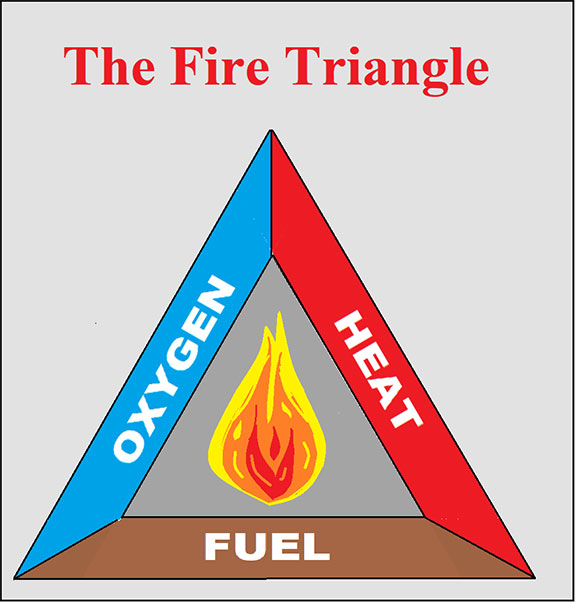How do fires start?
Keeping the Flock Safe from Fire

Based on the Sheepdog Church Security Training Course
Arson Prevention and Fire Drills for Churches [1]
In the Bible
How great a forest is set ablaze by such a small fire! (James 3:5).
Now if anyone builds ... with ... wood, hay, straw, it will be revealed by fire, and the fire will test what sort of work each one has done (1 Corinthians 3:12-13).
Can a man carry fire next to his chest and his clothes U? (Proverbs 6:27).
As fire consumes the forest, as the flame sets the mountains ablaze (Psalm 83:14).
And he sent out arrows and scattered them; lightning, and routed them (2 Samuel 22:15).
In the News
Various kinds of thefts in churches are reported in the news:
Burglary
Pittsburgh, Pennsylvania, September 9, 2019 – A church next door to a fire station was heavily damaged in a Monday afternoon fire. A crew repairing the roof got out safely, but one firefighter was injured. The cause is under investigation, but the construction of the ceiling made fighting the fire more difficult.[2]
Chicago, Illinois, December 1, 1958 – Ninety-five persons (3 nuns and 92 students) died in a fire at Our Lady of the Angels School. The fire began in a trash container at the foot of a stairwell. This tragedy sparked a movement for fire safety in schools across North America and in Europe with an emphasis on planned evacuation routes and fire drills.[3]
Greely, Colorado, July 7, 2019 – Lightning struck the steeple of a church in Greely during a Sunday evening service, causing a fire. The 180 congregants were safely evacuated.[4]
New York City, May 1, 2016 – The fire that destroyed the Serbian Orthodox Cathedral in Manhattan was probably caused by smoldering candles not properly disposed.[5]
Middletown, Ohio, January 22, 2019 – A teen-age boy broke into a church early Sunday morning, stole money and items, then set the church on fire. A second teen was charged with receiving stolen property and not reporting a crime.[6]
The Two Faces of Fire
An old saying (at least as far back as the 1700s) is, "Fire is a good servant but a bad master." Fire has many uses: heating buildings, cooking, hot water, refining metals, propelling vehicles. In each of these cases, the fire is controlled. Uncontrolled fire is destructive, even fearsome. Examples of this are vehicle fires, house fires, and wildfires. Understanding what fire is, how it starts, and how it can be quenched is the key to knowing how to control it.

The Fire Triangle
One thing all fires have in common is putting together the three elements of a fire: Fuel, Oxygen, and Heat. Fire prevention keeps at least one element out of the equation. Fire suppression blocks or removes at least one of these. For church safety ministries seeking to improve fire safety, this means they look for places where these three elements might all be present and could be brought together, then seek to block or remove at least one these elements, at least keeping them apart.
Causes of Church Fires
One major responsibility of state and local fire marshals is the investigation of fires to determine their causes. This not only assigns liability for fires, but contributes to knowledge which is applied to fire prevention. Causes of church fires fall into a number of categories: Natural Causes, Physical Causes, and Behavioral Causes.
Natural Causes
Natural causes of fire are referenced in the Bible. The most common is lightning. Electric discharges in the atmosphere are essential to life on Earth, since they create nitric acid which comes down in thundershowers and is converted to nutrients by organisms in the soil. On the other hand, when lightning strikes objects on the ground - such as buildings - it causes fires. Most wildfires in the Pacific Northwest are caused by lightning. Properly designed, installed, and maintained lightning rods have spared many churches from fire.
Another natural cause of fie is spontaneous combustion. At least it is a natural cause when decaying vegetative matter builds up enough heat to ignite. This can be prevented around the church by not letting outside debris build up.
In a few areas, such as the Big Island of Hawaii, and settlements on the slopes of volcanoes in the Cascades, Sierra Nevada, Alaska, or Mexico and Central America, volcanic activity is a potential natural cause, as evidenced in the Kilauea eruptions of 2018. However, it is considered rare. The only reasonable way to prevent this is to build outside likely lava or pyroclastic flow zones.
Earthquakes can cause fires in populated areas, such as the 1906 San Francisco Quake. The November 30, 2018 Anchorage Earthquake downed a power line, starting a fire in a church. [7]
Physical Causes
Here we are speaking of fires started by human-made objects. Spontaneous combustion of oily rags should be considered not natural, but physical. Also included is ignition by chemical reactions. However, the most common physical causes are overloaded electrical wiring, electrical shorts, friction in worn-down moving parts (such as in a fan), and malfunctioning heating systems. Engine fires in vehicles can spread to adjacent buildings, especially when they are in garages.
Behavioral Causes
Behavioral causes of fire fall into a few categories: Carelessness, Negligence, Ignorance, and Arson.
Carelessness
Carelessness is, collectively, the most common behavioral cause of fires. Campfires improperly made and left unattended or not properly extinguished have started many wildfires. Smoking items - such as cigarettes, cigars, and pipe tobacco - have started their share of fires. This includes cigarettes left in upholstery or dropped into mulch or trash containers, smoking in bed, and lighting up around volatile flammable liquids (such as gasoline).
Leaving oily rags in burnable containers is carelessness which may lead to fire. So is leaving reactive chemicals where they can leak or spill and mix. Other fire-causing carelessness includes leaving food unattended on hot burners, leaving combustible materials too close to heat sources, and improper disposal of hot waste (such as fireplace ashes or candles).
Negligence
Some physical causes of fire can be chalked up to negligence. This includes not having furnaces cleaned and inspected before the heating season begins, not maintaining mechanical equipment, not replacing worn-out equipment, and not evaluating and updating the church's electrical wiring.
Ignorance
Let's face it! We don't know everything. Some fire hazards might not be addressed because they are not recognized or we don't know what to do about them. Ask your church's insurance provider to advise you on what to look for and how to remedy fire hazards. Also, even if your church may be exempt from fire inspections (in some places they are), invite the fire department to inspect the premises and point out issues that should be taken care of. After all, what we don't know can hurt us.
Arson
A common cause of church fires is arson. It may be an attempt to cover up a burglary, as in Middletown. It may be vandalism. Some fires are set by mentally ill persons and pyromaniacs. Several fires have been set as hate crimes, and a few of these have been hoaxes (attempts to pin hate crimes on others or to gain sympathetic news coverage). Even in churches, some people may set fires for insurance fraud or to cover embezzlement.
Know the Cause, Find the Cure
One goal of medical research has been to know the cause and find the cure for diseases. A similar approach may be applied to church fire safety: Know the cause of fires so we can prevent them. The Sheepdog Church Security Training Course "Arson Prevention and Fire Drills for Churches" includes ways to find and neutralize fire hazards in your church.
There is More
Other articles in this series for Fire Safety Month are "Block It" (Preventing a Conflagration), "Quench It" (Fire Suppression), and "Out from Danger" (Evacuations and Fire Drills).
References
- Kris Moloney, "Arson Prevention and Fire Drills for Churches," Sheepdog Church Security Training Courses, Training Materials (Classes) [https://sheepdog-church-security.thinkific.com/courses/arson-prevention-and-fire-drills-for-churches-training-bundle], Online Training (Individual) [https://sheepdog-church-security.thinkific.com/courses/arson-prevention-and-fire-drills-for-churches].
- Chris Hoffman, "1 Firefighter Injured After Fire Breaks Out At Sheraden Church," KDKA2 CBS Pittsburgh, September 9, 2019 [https://pittsburgh.cbslocal.com/2019/09/09/sheraden-united-methodist-episcopal-church-fire/].
- Wikipedia, "Our Lady of the Angels School fire," [https://en.wikipedia.org/wiki/Our_Lady_of_the_Angels_School_fire].
- Emily Wenger, "Lightning reportedly strikes Greeley church's steeple, sparks fire," Fox31, July 7, 2019 [https://kdvr.com/2019/07/07/lightning-strikes-greeley-churchs-steeple-sunday-night-sparks-fire/].
- Shawn Cohen and Chris Perez, "https://nypost.com/2016/05/03/massive-cathedral-fire-may-have-been-caused-by-church-candles/," The New York Post, May 3, 2016 [https://nypost.com/2016/05/03/massive-cathedral-fire-may-have-been-caused-by-church-candles/].
- Rick McCrabb, "Teen charged with setting Middletown church fire gives no plea," Journal-News, Jan 24, 2017 [https://www.journal-news.com/news/teen-charged-with-setting-middletown-church-fire-gives-plea/MELaksBGMY3dEOHm9TqIzN/].
- Anon., "Damaged power lines from earthquake suspected cause of church fire in Anchorage, Alaska," Global News/Corus News, November 30 2018 [https://globalnews.ca/video/4717547/damaged-power-lines-from-earthquake-suspected-cause-of-church-fire-in-anchorage-alaska].




